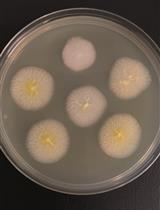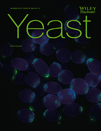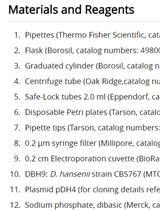- EN - English
- CN - 中文
Single-step Marker Switching in Schizosaccharomyces pombe Using a Lithium Acetate Transformation Protocol
在粟酒裂殖酵母中采用醋酸锂转化方案进行标记基因的单步转换
发布: 2016年12月20日第6卷第24期 DOI: 10.21769/BioProtoc.2075 浏览次数: 9584
评审: Yanjie LiBelen SanzAnonymous reviewer(s)

相关实验方案

利用一个CRISPR/Cas9载体对棉囊阿舒氏酵母进行基因组编辑
Gloria Muñoz-Fernández [...] José Luis Revuelta
2020年06月20日 4792 阅读
Abstract
The ability to utilize different selectable markers for tagging or mutating multiple genes in Schizosaccharomyces pombe is hampered by the historical use of only two selectable markers, ura4+ and kanMX6; the latter conferring resistance to the antibiotic G418 (geneticin). More markers have been described recently, but introducing these into yeast cells often requires strain construction from scratch. To overcome this problem we and other groups have created transformation cassettes with flanking homologies to ura4+ and kanMX6 which enable an efficient and time-saving way to exchange markers in existing mutated or tagged fission yeast strains.
Here, we present a protocol for single-step marker switching by lithium acetate transformation in fission yeast, Schizosaccharomyces pombe. In the following we describe how to swap the ura4+ marker to a kanMX6, natMX4, or hphMX4 marker, which provide resistance against the antibiotics G418, nourseothricin (clonNAT) or hygromycin B, respectively. We also detail how to exchange any of the MX markers for nutritional markers, such as arg3+, his3+, leu1+ and ura4+.
Background
This single-step marker swap protocol for Schizosaccharomyces pombe allows for any tagged or mutated gene marked with an MX-type antibiotic marker to be swapped for a nutritional marker (cassettes containing the arg3+, his3+, leu1+, and ura4+ have been constructed) and to exchange genetic ura4+-markers for any MX-type antibiotic resistance marker (kanMX, natMX, and hphMX constructs have been tested for this study) (Lorenz et al., 2015a). Previously, this kind of approach was only feasible for MX-type antibiotic resistance markers (Sato et al., 2005; Hentges et al., 2005). Exchanging antibiotic resistance markers for each other already represented a basic set of useful genetic tools, the ura4+-to-MX as well as the arg3MX4, his3MX4, leu1MX4, and ura4MX4 marker swap cassettes expand this genetic toolbox for tagging and mutating genes in fission yeast (Lorenz et al., 2015a). The lithium acetate transformation protocol itself was described previously (Keeney and Boeke, 1994) and recently suggested modifications (http://listserver.ebi.ac.uk/pipermail/pombelist/2014/004012.html) were incorporated to provide a highly efficient procedure. Streamlining Schizosaccharomyces pombe strain construction in this way is time-saving and, therefore, will prove useful for fission yeast researchers.
Materials and Reagents
- Conical tubes:
15 ml (Greiner Bio One, catalog number: 188261 )
50 ml (Greiner Bio One, catalog number: 227261 ) - 1.5 ml centrifuge tubes (Greiner Bio One, catalog number: 616201 )
- 0.2 ml flat-cap PCR tubes (Corning, Axygen®, catalog number: PCR-02-C )
- Petri dishes (Greiner Bio One, catalog number: 633185 )
- BD Plastipak 10 ml syringes (BD, catalog number: 302188 )
- Millex-GP 33 mm diameter sterile syringe filter units (Polyethersulfone [PES] membrane, pore size: 0.22 µm) (EMD Millipore, catalog number: SLGPO33RS )
- Appropriate Schizosaccharomyces pombe strains: for a marker swap the strain must already carry a mutant or tagged gene marked with either an ura4+ or MX-type marker, such as kanMX, natMX, or hphMX (Bähler et al., 1998; Goldstein and McCusker, 1999). When introducing arg3MX4, his3MX4, leu1MX4, or ura4MX4 into a strain, this strain needs to be mutated for the respective gene at its original locus, e.g., arg3-D4 (Waddell and Jenkins, 1995), his3-D1 (Burke and Gould, 1994), leu1-32 (Keeney and Boeke, 1994), or ura4-D18 (Grimm et al., 1988).
- Plasmids: pALo120 (FYP2884), pALo121 (FYP2885), pALo122 (FYP2886), pFA6a-arg3MX4 (FYP2890), pFA6a-his3MX4 (FYP2891), pFA6a-leu1MX4 (FYP2892), and pFA6a-ura4MX4 (FYP2893) (Lorenz, 2015a and 2015b); plasmid can be obtained from the National BioResource Project (NRBP) of MEXT, Japan (please refer to FYP numbers when ordering).
- Sonicated salmon sperm DNA (Sigma-Aldrich, catalog number: 31149 )
- Agarose, molecular grade (Bioline, catalog number: BIO-41026 )
- Q5 high fidelity DNA polymerase (New England Biolabs, catalog number: M0491 )
- 5x Q5 reaction buffer (accessory part of Q5 high fidelity polymerase) (New England Biolabs, catalog number: M0491 )
- 10 mM dNTPs (Thermo Fisher Scientific, Thermo ScientificTM, catalog number: R0191 )
- 10 µM oligonucleotides (to be used as primers in PCR reactions) (Sigma-Aldrich, USA)
- MilliQ H2O drawn from a MilliQ Advantage A10 system (EMD Millipore, catalog number: Z00Q0V0WW )
- CutSmart buffer (accessory part of restriction enzymes, can also be ordered separately under New England Biolabs, catalog number: B2704 )
- Restriction enzymes:
XbaI restriction enzyme (New England Biolabs, catalog number: R0145 )
BamHI-HF restriction enzyme (New England Biolabs, catalog number: R3136 )
EcoRI-HF restriction enzyme (New England Biolabs, catalog number: R3101 )
PvuII-HF restriction enzyme (New England Biolabs, catalog number: R3151 )
SacI-HF restriction enzyme (New England Biolabs, catalog number: R3156 ) - Di-methyl sulfoxide (DMSO) (Sigma-Aldrich, catalog number: D8418 )
- Ethylenediaminetetraacetic acid (EDTA) (Thermo Fisher Scientific, Fisher Scientific, catalog number: 10526383 )
- Sodium hydroxide (NaOH) pellets (anhydrous) (Sigma-Aldrich, catalog number: S8045 )
- Tris(hydroxymethyl)aminomethane (VWR, catalog number: 103156X )
- Glacial (100%) acetic acid (VWR, catalog number: 20104.334 )
- Yeast extract, microgranulated (ForMediumTM, catalog number: YEM02 )
- Glucose anhydrous (Thermo Fisher Scientific, Fisher Scientific, catalog number: 10373242 )
- Adenine (Sigma-Aldrich, catalog number: A5665 )
- Uracil (ForMediumTM, catalog number: DOCO212 )
- Leucine (ForMediumTM, catalog number: DOCO156 )
- Lysine (Sigma-Aldrich, catalog number: L8662 )
- Histidine (Sigma-Aldrich, catalog number: H5659 )
- Arginine (Sigma-Aldrich, catalog number: A6969 )
- Agar granulated (ForMediumTM, catalog number: AGR10 )
- G418 disulfate (ForMediumTM, product number: G4181 )
- Nourseothricin-dihydrogen sulfate (clonNAT) (Werner BioAgents, catalog number: clonNAT)
- Hygromycin B (ForMediumTM, catalog number: HYG1000 )
- Yeast nitrogen base without amino acids and without ammonium sulfate (ForMediumTM, catalog number: CYN0502 )
- L-glutamic acid monosodium salt hydrate (sodium glutamate) (Sigma-Aldrich, catalog number: G5889 )
- 5 N hydrochloric acid (HCl) (VWR, catalog number: 30018.320 )
- Lithium acetate (Sigma-Aldrich, catalog number: L4158 )
- Polyethylene glycol (PEG) MW 3,350 (Sigma-Aldrich, catalog number: P4338 )
- DNA molecular weight marker, HyperLadderTM 1 kb (Bioline, catalog number: BIO-33025 )
- 0.5 M EDTA (pH 8.0) (see Recipes)
- 50x TAE gel electrophoresis buffer (see Recipes)
- YES (Yeast extract supplemented) broth (see Recipes)
- YES plates (see Recipes)
- Concentration of antibiotics in YES media (see Recipes)
- YNG (Yeast nitrogen base glutamate) plates (see Recipes)
- 1 M Tris/HCl (pH 7.5) (see Recipes)
- 1 M LiAc (pH 7.5) (see Recipes)
- 10x TE (pH 7.5) (see Recipes)
- LiAc/TE (see Recipes)
- 40% PEG (see Recipes)
Equipment
- Erlenmeyer glass flasks for culturing yeast (DURAN Group, catalog number: 2177144 )
- Infors HT multitron standard shaking incubator (Infors, model: Multitron Standard )
- Static incubator (Gallenkamp forced air incubator) (Weiss Technik UK)
- Water baths (Grant Instruments, catalog number: JBN5 )
- Eppendorf microcentrifuge (Eppendorf, model: 5424R )
- MJ Research PTC-100 programmable thermal cycler
- Nucleic acid gel electrophoresis system consisting of a gel electrophoresis chamber with a 7 x 10 cm tray (Bio-Rad Laboratories, model: Mini-Sub® Cell GT ) and a power supply (Bio-Rad Laboratories, model: PowerPacTM Basic Power Supply )
- NanoDrop 2000c UV/Vis-spectrophotometer (Thermo Fisher Scientific, Thermo ScientificTM, model: ND-2000C )
- Sigma 4-16K centrifuge (Sigma Laborzentrifugen, model: Sigma 4-16K )
- Haemocytometer, type Neubauer improved (Marienfeld-Superior, catalog number: 0630010 )
- Leica DM500 microscope (Leica Microsystems, model: Leica DM500 )
- Classic Media 12 L autoclave (Prestige Medical, model: 210048 )
Procedure
文章信息
版权信息
© 2016 The Authors; exclusive licensee Bio-protocol LLC.
如何引用
Brown, S. D. and Lorenz, A. (2016). Single-step Marker Switching in Schizosaccharomyces pombe Using a Lithium Acetate Transformation Protocol. Bio-protocol 6(24): e2075. DOI: 10.21769/BioProtoc.2075.
分类
微生物学 > 微生物遗传学 > 基因图谱和克隆
微生物学 > 微生物遗传学 > 转化
分子生物学 > DNA > DNA 重组
您对这篇实验方法有问题吗?
在此处发布您的问题,我们将邀请本文作者来回答。同时,我们会将您的问题发布到Bio-protocol Exchange,以便寻求社区成员的帮助。
Share
Bluesky
X
Copy link












